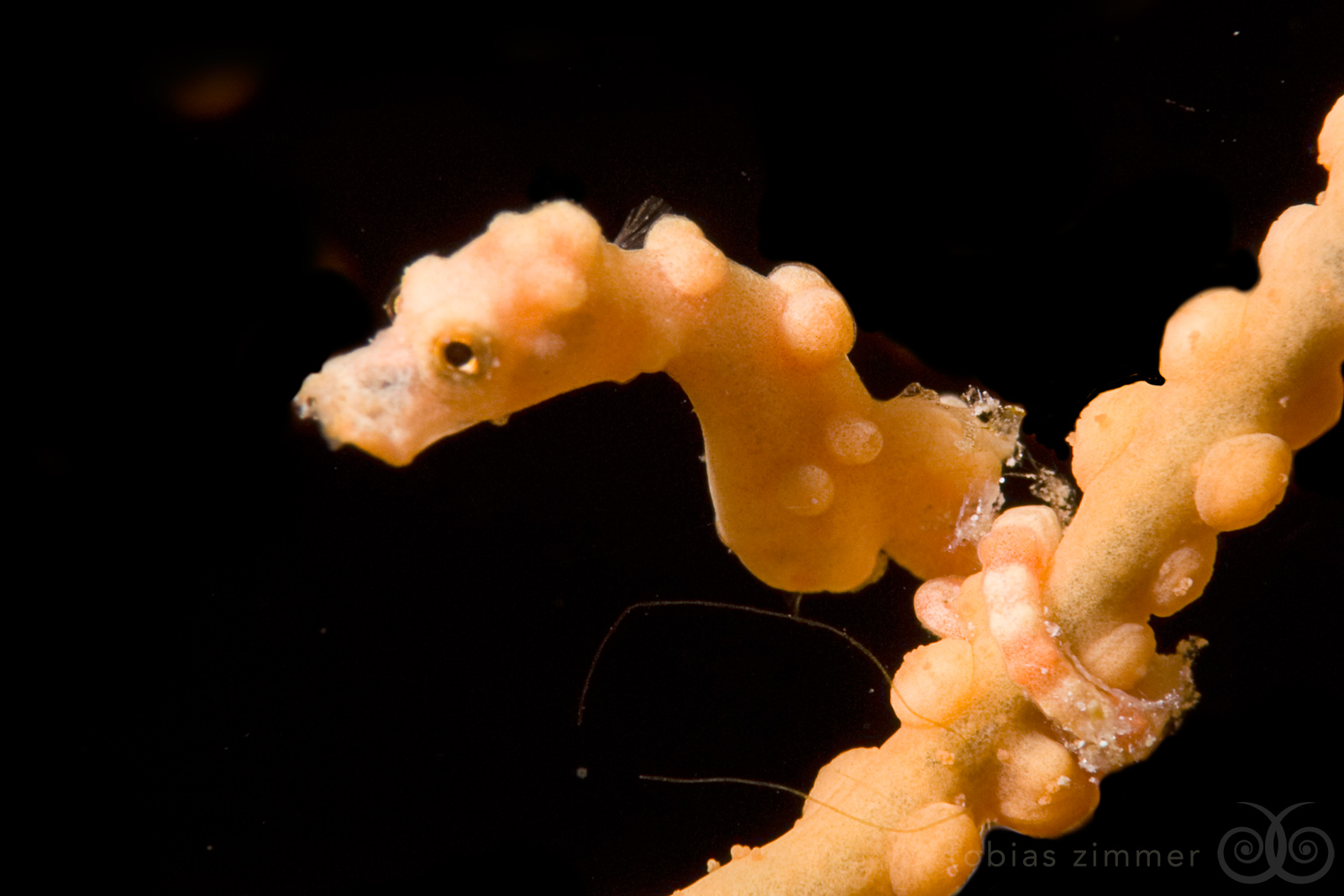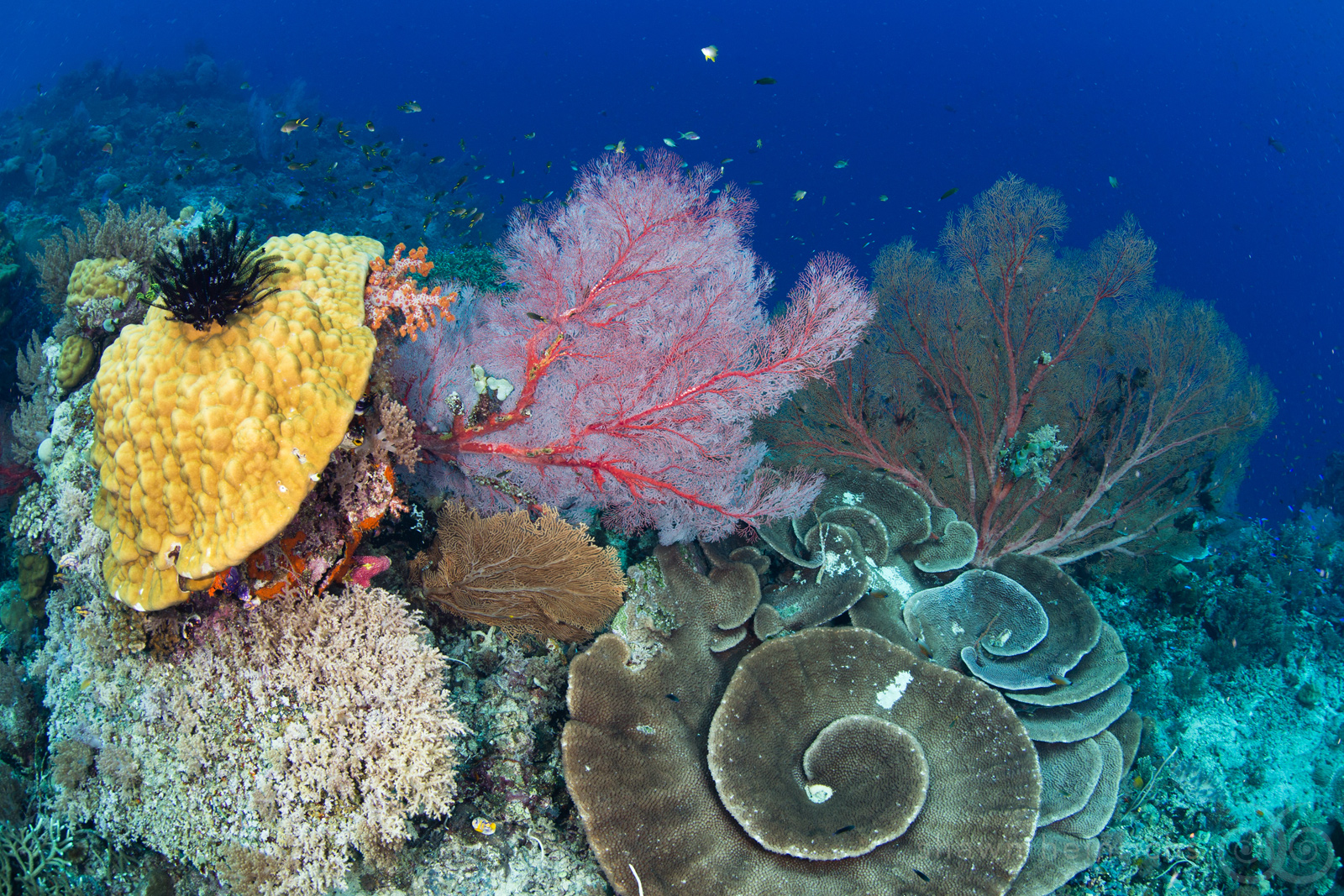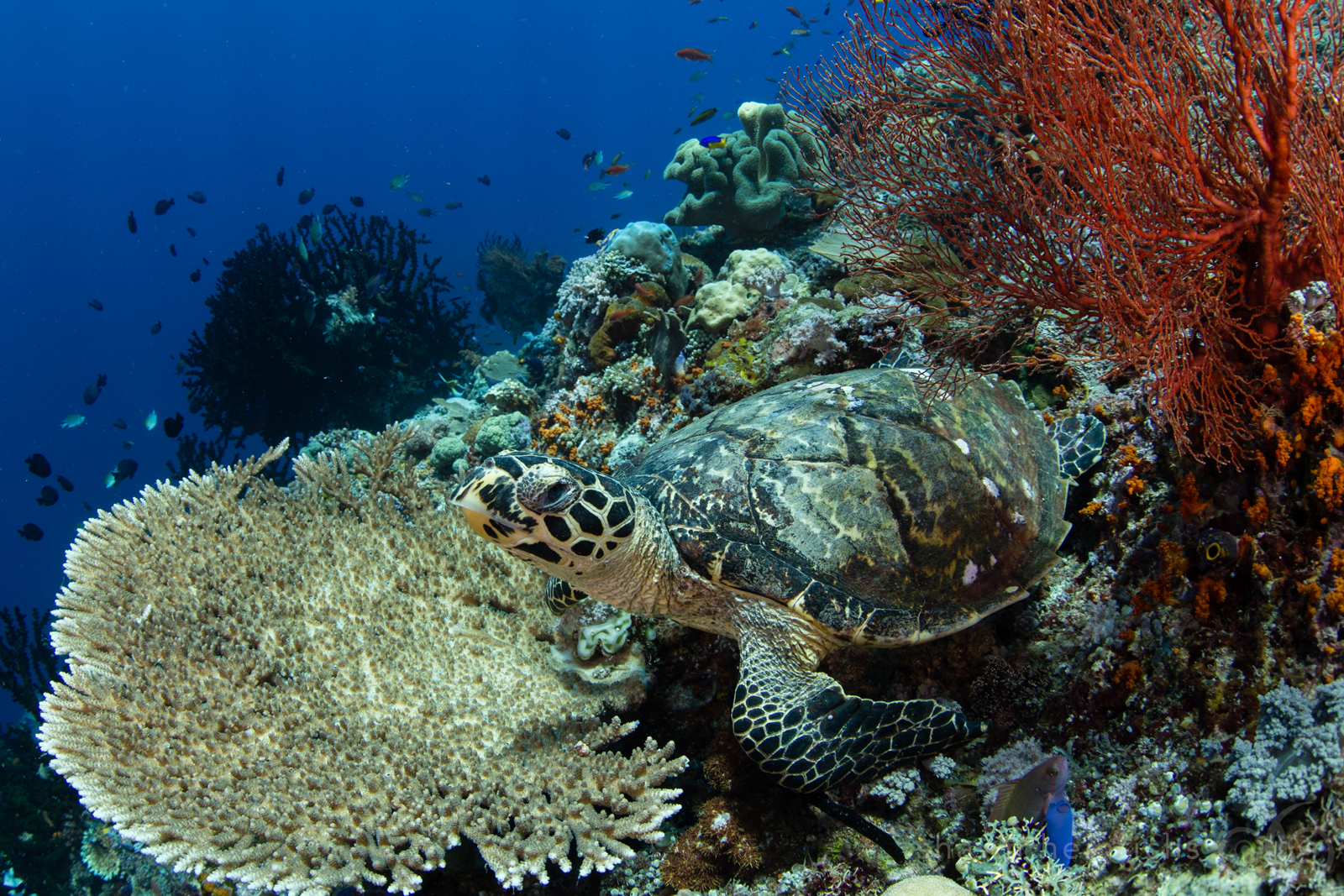House Reef: a world class shore dive
Our House Reef is a shore dive, easily accessed at any time from either the end of the jetty or from the steps in the North Lagoon. On a rising tide, jump off the end of the jetty and enjoy an easy drift North through the channel, which is exposed to variable current. Schooling horse-eyed jacks congregate under the pier, joined by massive schools of fusiliers and shoals of passing anchovies. Several very large groupers make their home in the depths under the jetty, and they often appear to inspect visitors to their reef. We regularly see large black tip reef sharks patrolling the deeper areas, as well as the occasional grey reef shark.
As you drift north through the channel, the topography shifts from a gentle slope to steep wall, festooned with colourful soft corals, huge gorgonian sea fans, and sea squirts and tunicates in a multitude of sizes and shapes. Careful inspection of the many rocky outcroppings, coral bommies, and overhangs is always rewarded with a treasure. A close look at Muricella and Annella sea fans often reveals the elusive Bargibanti and Denise pygmy seahorses. Large and colourful crinoids often cling to the fans as well, hosting a menagerie of colour-coordinated cling fish, crinoid shrimp, and arrowhead crabs.
If you time your dive just right, you'll have a good chance of seeing the stunning Mandarin Fish, who make their appearance just before sunset. A little patience will be rewarded with a display of their wildly psychedelic courtship ritual. They are joined by the spectacular displays of several species of Flasher Wrasse. We also regularly spot the newly-discovered 'walking' Epaulette Shark in the shallows, scooting along with their pectoral fins and hunting for their next meal.
You'll also find innumerable species of nudibranchs and flatworms. These range from the gaily coloured black and orange spotted Nembrotha to the huge white Ardeadoris egretta, edged with a lemon yellow frill. It's not unusual to spot up to 10 different species of nudibranchs and flatworms on a single dive. The reef wall is also home to an unrivalled variety of soft corals, hard corals, and sponges, in all colours of the spectrum. We've even got fluorescent hard corals!
The House Reef is particularly well suited to photographers and those who enjoy observing unusual animal behaviour. Inspect holes in the sandy substrate and you may find the unlikely duo of goby and shrimp. These two share a burrow: the goby keeps a look out on behalf of himself and the blind shrimp, alerting it to danger with a wiggle of its tail. In exchange, the shrimp keeps the burrow tidy. Stop to watch it bulldoze the sand and pebbles away from the burrow with its claws. We also regularly see octopus hunting or mating in the shallows, and the occasional blue-ringed octopus flashing its vibrant spots in warning.
If you haven't seen it already, we recommend the 'Shallow Seas' episode of the BBC series 'Life.' Peter Schoons and his team spent 6 weeks filming on our House Reef to capture the sequence of anemone fish tending their brood!
Local Reefs: variety and quality of live-aboard diving combined with all the comforts of a private island resort.
We have explored over 60 dive-sites within a 1-hour radius of the resort, and there are many more waiting to be explored. We are pleased to offer over 25 world-class dive sites within a 15-minute radius of the resort, including Fiabacet, Boo, Yilliet, Wobbegong City, and Magic Mountain.
The 3D underwater footage of the recent IMAX film 'Journey to the South Pacific' was filmed on Misool Resort's incredible dive sites.
You can expect to dive a diverse selection of sites, including a busy manta cleaning station, coral covered walls, reef flats, swim throughs, gentle sea mounts, drift dives, vast hard-coral gardens, placid lagoons, and current-raked pinnacles. Visibility is variable but generally 25+ meters, with temperatures around 26-28 degrees Celsius (78-82 degrees Fahrenheit).
All of our dive sites are protected by our own 300,00 acre/1,220 sq km Misool Marine Reserve. That means that an area twice the of Singapore is a dedicated conservation area, and free from all fishing. Here are just a few of our most famous sites:
Nudi Rock: a small island in the Fiabacet chain, which looks an awful lot like a nudibranch from a distance. Just a quick 5-minute speed boat ride from the jetty, this site is a must for critter enthusiasts and macro photographers. True to its name, you'll find a wide range of flamboyant nudibranchs lurking among the abundant soft corals. The sea fans are well populated with pygmy seahorses and cowries. Be sure to inspect the abundant crinoids for their colour-coordinated arrowhead shrimp and cling fish. When currents allow, this site is also popular for its pinnacles crowded with larger pelagics like Barracuda, Big Eyed Travelly, and the odd mature Grey Reef Shark. The sloping shallows of Nudi Rock are stunning for wide angle shots with exquisite colours and hard coral gardens.
Magic Mountain: This sea mount is located about 20 minutes from the resort, and is a busy Manta ray cleaning station. The submerged pinnacle reaches up to about 7 meters, and you have a very good chance of seeing not one by TWO species of manta rays here - both the giant Oceanic birostris as well as the smaller reef manta, alfredi. Magic Mountain is also a nursery for White Tip Reef Sharks and a love nest for Napoleon Wrasse. Because this site is completely exposed to oceanic currents, you can expect to see large schools of pelagics in the blue. Learn more about the Misool Manta Project here.
Yillet: The huge island of Yillet stretches east to west about 15 minutes north of our resort island. This island used to be home to an itinerant shark finning camp, and we are pleased by the stunning resurgence of life on its surrounding reefs, including sharks. One of Yillet's tiny satellite islands is particularly rich and topographically weird. The tiny island has been undercut by untold millenia of wave action, forming an umbrella over a sloping underwater plateau with numerous spooky overhangs and cavelets. Diving with a torch is highly recommended for this site - you'll want to illuminate the dark corners of this site to see all the critters, as well as the wild colours. Barramundi cod and Hawksbill Turtles frequent this site. We also suggest you keep a sharp eye on the blue, as huge schools of barracuda hover in formation.
Boo Windows: One of our most famous dive sites, named for its unique topography. The site is a small island about 15 minutes from the resort, with 2 swim-through 'windows' carved into it. The South West face of this site is quite steep and exposed to current, so you are likely to see patrolling sharks as well as the elusive Wobbegong Shark - be sure to look under the massive table corals! When the currents are right, we'll move off towards a large pinnacle in the blue. The pinnacle is often surrounded by pulsating schools of fusiliers and gangs of plate-sized Batfish. Heading back towards the Windows, notice how the sunlight filters through - it's like nothing else on earth! We'll follow the plateau of hard plate corals and look for Sweetlips hiding underneath. Be sure to investigate the huge Barrel Sponges - their crevices often conceal Hairy Squat Lobsters.












![DSC_-103-[1600x1200].jpg](https://images.squarespace-cdn.com/content/v1/58938827440243086b10a65b/1486330361550-3MZ1GO0RNOK3OJ2ZDCVV/DSC_-103-%5B1600x1200%5D.jpg)
















